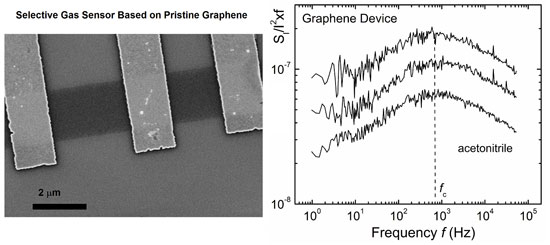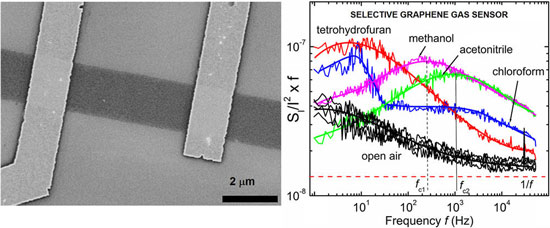| Posted: Apr 26, 2012 | |
Selective gas sensing with pristine graphene |
|
| (Nanowerk Spotlight) It has been known for some time that graphene can be used for detection of individual gas molecules adsorbed on its surface. Back in 2007, the discoverers of graphene, Andre Geim and Kostya Novoselov, already reported a graphene sensor that can detect just a single molecule of a toxic gas (see: "Graphene sniffs out dangerous molecules"). In that work, the researchers have shown that gas molecules gently attach themselves to graphene without disrupting its chicken wire structure. They only add or take away electrons from graphene, which results in notable changes in its electrical conductance. | |
| However, the extremely high sensitivity of graphene does not necessarily translate into its selectivity to various molecules. In other words, it can be detected that some molecules attached to the graphene surface change the resistivity of a graphene field-effect transistor but one cannot say what kind of a molecules have attached. Scientists have therefore thought that truly selective gas sensing with graphene devices requires the functionalization of graphene surface with some agents specific for different gas molecules. | |
| In new research, though, scientists have now found that chemical vapors change the noise spectra of graphene transistors: A team of researchers from the Center for Integrated Electronics of the Rensselaer Polytechnic Institute, Nano-Device Laboratory of the University of California - Riverside (UCR), The Ioffe Physical-Technical Institute of The Russian Academy of Sciences, and the GE Global Research center demonstrated that the use of an unusual sensor parameter – low-frequency electronic noise – allows one to perform selective gas sensing for many vapors with a single device made of pristine graphene – no functionalization of the graphene surface required. | |
| These results prove that graphene's capabilities for selective gas detection are better than previously thought if one uses low-frequency electronic noise as an additional sensing parameter. The noise signal for each gas is reproducible (see Figure 1) opening the way for practical reliable and simple gas sensors made from graphene. | |
 |
|
| Figure 1: Scanning electron microscopy images of back-gated graphene devices used as selective gas sensors (left panel). Noise spectral density SI/I2 multiplied by frequency f versus frequency f for three different single-layer-graphene transistors exposed to acetonitrile vapor. Note the excellent reproducibility of the noise response of the graphene devices showing the same frequency fc for all three devices. (The image is courtesy of Prof. Alexander A. Balandin) | |
| The breakthrough results on selective gas sensing with a single pristine graphene devices were reported in the April 16, 2012 online edition of Nano Letters ("Selective Gas Sensing with a Single Pristine Graphene Transistor"). | |
| "It is interesting that the motivation for this work was not a desire to make a better sensor but rather a curiosity of what happens with the low-frequency noise response of graphene devices exposed to various vapors," Alexander Balandin, a corresponding author for the Nano Letters paper, who is Professor of Electrical Engineering and Founding Chair or Materials Science and Engineering at UCR, tells Nanowerk. "It turned out that some gases induce very clear peaks in the noise spectra, which could be used as their signatures in sensor devices." | |
| The graphene devices for this study were fabricated in Balandin's Nano-Device Laboratory (NDL) by PhD Candidate Guanxiong Liu. Other members of the interdisciplinary team participated in this research were Dr. Michael Shur, Patricia W. and C. Sheldon Roberts Professor of Solid State Electronics at the Rensselaer Polytechnic Institute, Dr. Sergey Rumyantsev of the Ioffe Institute and Dr. Radislav Potyrailo, Principal Scientist of the GE Global Research Center. | |
| What's so interesting here is that noise is usually considered as one of the main limiting factors for a gas sensor's operation. The fact that low-frequency noise spectra of graphene is affected in different ways by the vapors of different chemicals, demonstrates that noise can be used to discriminate between different gases. | |
| In their Nano Letters paper, the team shows that vapors of different chemicals produce distinguishably different effects on the low-frequency noise spectra of graphene. Specifically, they found that gases modify the noise spectra by inducing Lorentzian components with distinctive features. | |
| The characteristic frequency fc of the Lorentzian noise bulges in graphene devices is different for different chemicals and varies from fc=10-20 Hz to fc=1300-1600 Hz for tetrahydrofuran and chloroform vapors, respectively (see Figure 2). The obtained results indicate that the low-frequency noise in combination with other sensing parameters can allow one to achieve the selective gas sensing with a single pristine graphene transistor. The proposed method of gas sensing with graphene does not require graphene surface functionalization or fabrication of an array of the devices with each tuned to a certain chemical. | |
 |
|
| Figure 2: Scanning electron microscopy image of back-gated graphene devices used as selective gas sensors (left panel). Noise spectral density SI/I2 multiplied by frequency f versus frequency f for the device in open air and under the influence of different vapors. Different vapors induce noise with different characteristic frequencies fc. The frequencies, fc, are shown explicitly for two different gases. The solid lines show the polynomial fitting of the experimental data. The difference in the frequency fc is sufficient for reliable identification of different gases with the same graphene transistor. For comparison the pure 1/f noise dependence is also indicated. (The image is courtesy of Prof. Alexander A. Balandin) | |
| Balandin points out that, while the gas signatures in the noise spectra of graphene devices are well reproducible, the physics of processes leading to the characteristic peaks in the noise spectra are not completely understood. | |
| "We plan to spend some effort on correlating the parameters of the molecules attached to the graphene surface with the energies of the peaks," he says. | |
| The work at RPI was supported by the US NSF under the auspices of I/UCRC "CONNECTION ONE", by the NSF EAGER program and the Russian Fund for Basic Research (RFBR). The work at UCR was supported by the Semiconductor Research Corporation (SRC) and the Defense Advanced Research Project Agency (DARPA) through FCRP Center on Functional Engineered Nano Architectonics (FENA) and the US National Science Foundation (NSF). The work at GE was supported by GE Corporate long term research funds. | |
 By
Michael
Berger
– Michael is author of three books by the Royal Society of Chemistry:
Nano-Society: Pushing the Boundaries of Technology,
Nanotechnology: The Future is Tiny, and
Nanoengineering: The Skills and Tools Making Technology Invisible
Copyright ©
Nanowerk LLC
By
Michael
Berger
– Michael is author of three books by the Royal Society of Chemistry:
Nano-Society: Pushing the Boundaries of Technology,
Nanotechnology: The Future is Tiny, and
Nanoengineering: The Skills and Tools Making Technology Invisible
Copyright ©
Nanowerk LLC
|
|
|
Become a Spotlight guest author! Join our large and growing group of guest contributors. Have you just published a scientific paper or have other exciting developments to share with the nanotechnology community? Here is how to publish on nanowerk.com. |
|
